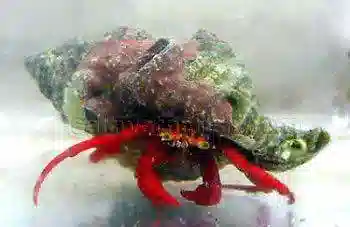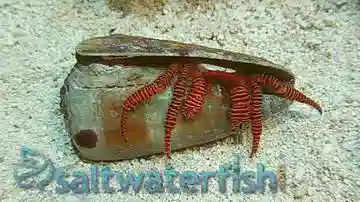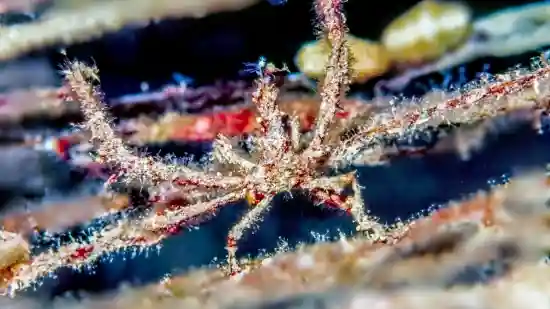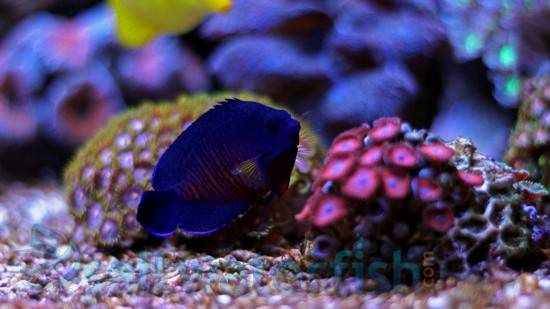Scarlet Hermit Crab
Paguristes cadenati
(53 Reviews)

Scarlet Hermit Crab
Paguristes cadenati
(53 Reviews)
{{ item.name }}
Size: {{ item.extra_field_3 }}
${{ getFormattedPrice(item.saleprice) }} ${{ getFormattedPrice(item.price) }}
To join the waiting list, click here
Free Shipping
With
$199.00
or more in Marine Life.
More details...
Scarlet Hermit Crab Care Facts
| Care Level: | Easy |
|---|---|
| Temperament: | Peaceful |
| Diet: | Omnivore |
| Reef Safe: | Yes |
| Minimum Tank Size: | 5 Gallons |
| Max Size: | 1 inch |
Scarlet Hermit Crab
The Scarlet Hermit Crab, known for its striking red body and legs, is an invaluable addition to marine aquariums, diligently scavenging detritus and aerating sand beds. Originating from the Western Atlantic Ocean, these hardy crabs thrive in shallow reef environments. They typically grow to 1 to 2 inches in shell length and have a slow but steady growth rate in captivity. Feeding them is straightforward, as they eagerly consume algae, detritus, and various foods, contributing to the tank's cleanliness.
Scarlet Hermit Crabs are compatible with Nassarius and Astrea snails, Peppermint Shrimp, Blue Leg Hermit Crabs, and Clownfish, fostering a diverse ecosystem. To ensure their well-being, provide a tank of at least 5 gallons with stable water conditions and gentle to moderate water flow. Sourcing from Saltwaterfish.com guarantees high-quality, healthy specimens, enriching your aquarium's biodiversity and maintaining its vibrancy.
Habitat
The Scarlet Hermit Crab (Paguristes cadenati) hails from the Western Atlantic Ocean and is commonly found in shallow reef environments and intertidal zones. These hardy hermit crabs are well adapted to life on the ocean floor, and they play a vital role in keeping the substrate clean by scavenging for food and detritus.
Size and Lifespan
Scarlet Hermit Crabs are relatively small, typically growing to a maximum size of about 1 to 2 inches in shell length. In captivity, they have a lifespan of several years, making them a long-lasting and engaging addition to your marine aquarium. Regardless of size, they are voracious cleaners.
Slower Growth Rate
The growth rate of Scarlet Hermit Crabs is relatively slow and steady. Diet, water conditions, and shell availability influence their growth. With proper care, they can gradually increase in size over the years.
Dietary Needs in Captivity
Providing a balanced diet that includes marine pellets, algae wafers, and occasional meaty foods like brine shrimp or fish flakes is recommended to keep them healthy.
Compatibility with Other Fish and Invertebrates
- Nassarius Snails (Nassarius spp.): These burrowing snails help stir and aerate the substrate while scavenging for detritus, making them suitable companions for Scarlet Hermit Crabs.
- Astrea Snails (Astrea spp.): These snails are efficient algae grazers, contributing to maintaining a clean and algae-free aquarium.
- Peppermint Shrimp (Lysmata wurdemanni): Peppermint shrimp are known for their ability to control pest anemones in your tank while coexisting peacefully with Scarlet Hermit Crabs.
- Blue Leg Hermit Crab (Clibanarius tricolor): These hermit crabs share similar care requirements with Scarlet Hermit Crabs and can be added for variety.
- Clownfish (Amphiprioninae): Clownfish often form symbiotic relationships with Scarlet Hermit Crabs, seeking refuge within their shells.
Tank Requirements
To ensure the well-being of your Scarlet Hermit Crabs, it's essential to provide the following tank conditions:
- Minimum Aquarium Size: A suitable tank for Scarlet Hermit Crabs should have a capacity of at least 5 gallons, providing ample space for a small group of these crabs.
- pH: Maintain a stable pH level between 8.1 and 8.4.
- Salinity: Keep salinity levels stable at 1.023 to 1.025.
- Water Temperature: Maintain a temperature range of 72-78°F (22-26°C).
- Number of Scarlet Hermit Crabs per 10 Gallons: Typically, you can house 5-10 Scarlet Hermit Crabs per 10 gallons of tank capacity.
Water Flow
Gentle to moderate water flow is recommended to replicate their natural habitat conditions and ensure efficient nutrient distribution.
Other Common Names
The Scarlet Hermit Crab is also known as the "Red Leg Hermit Crab" due to the distinctive red coloration of its legs.
Good tank cleaner.
Reviewed by: Russ Levenson on Nov. 19, 2025
Reviewed by: Glenda Pollard on Oct. 22, 2025
The Scarlet Hermit Crabs were all busy and happy when they arrived. They acclimated well and went into my tank. All in all, I will be ordering from you guys again soon. A WONDERFUL EXPERIENCE!!
Reviewed by: Morgan Shepherd on Oct. 6, 2025
Very nice
Reviewed by: John Jensen on Oct. 1, 2025
Reviewed by: Sherrie Mccomas on Sept. 17, 2025
Reviewed by: Cliff Anderson on July 23, 2025
Reviewed by: David Harris on July 2, 2025
Reviewed by: Ryan Vaughan on June 8, 2025
Reviewed by: Neil Tournoux on May 19, 2025
Huge
Reviewed by: Edmund Andracki on May 14, 2025
Reviewed by: Tami Curtis on April 20, 2025
Coral and crabs look good
Reviewed by: Robert Mcgill on April 16, 2025
Reviewed by: Thomas Hoefenkrieg on March 27, 2025
These guys are doing great
Reviewed by: Anthony Bare on March 26, 2025
Doing good
Reviewed by: Tennia Roberts on March 23, 2025
Good cleaners
Reviewed by: William Welch on March 9, 2025
Reviewed by: Ruben Sousa on March 4, 2025
Reviewed by: Abby Wilson on Feb. 12, 2025
Love these bright red crabs. They do what every hermit crab does and can’t really say they do any better than any other crab but they are way more attractive than. Almost any others.
Reviewed by: Leonard Pahlman on Feb. 3, 2025
Great and healthy
Reviewed by: Troy Walker on Feb. 2, 2025
Reviewed by: David Lalone on Jan. 2, 2025
Reviewed by: Scott Olson on Oct. 20, 2024
Reviewed by: Scott Olson on Oct. 14, 2024
Reviewed by: Denise Kloepping on Sept. 17, 2024
Reviewed by: Timothy Thomas on Sept. 11, 2024
Reviewed by: Pastor Reyes on Sept. 9, 2024
Look great and acclimating well
Reviewed by: Cameron Popkes on Sept. 9, 2024
Reviewed by: Javier Gonzalez on Aug. 20, 2024
Small but doing there job
Reviewed by: Ricky Hardee on Aug. 13, 2024
Great looking and active
Reviewed by: David Schneider on July 3, 2024
Reviewed by: Damon Guertin on June 27, 2024
Reviewed by: Michael Azoury on June 5, 2024
Reviewed by: Bryan Steele on May 21, 2024
Very bright legs, stands out from the rest
Reviewed by: Keith Blair on April 10, 2024
Reviewed by: David Schneider on March 12, 2024
Reviewed by: Eric Bell on March 3, 2024
Reviewed by: David Schneider on Feb. 19, 2024
Acclimated well. Working on algae.
Reviewed by: Jerry Albright on Jan. 29, 2024
They were healthy and hungry once acclimated.
Reviewed by: Sean Boyer on Jan. 16, 2024
Non stop eaters. Does their job well.
Reviewed by: Dale Pichelmayer on Dec. 12, 2023
Running allover tank
Reviewed by: Alvin Barbes on Nov. 6, 2023
Reviewed by: Gary Vice on Sept. 28, 2023
Arrived live and well
Reviewed by: Victor Paulino on Sept. 27, 2023
Reviewed by: Richard Walker on Sept. 27, 2023
Did their thing very well
Reviewed by: Alvin Barbes on Sept. 24, 2023
Reviewed by: Kyle Kolaja on Sept. 19, 2023
Reviewed by: Neil Tournoux on July 12, 2023
Bought 2 scarlet hermits that are just a tad small for me. At first they both hid. Then they came out and joined each other. Then they went in 2 different directions and the last few days I've only seen one of them. Hope the other is O.K. I think next time I'll go for a bit larger crab. They're getting along with their tankmates and have added not only to the "cleanup crew" tasks, but are a pretty and active addition to a normally slow and quiet seahorse tank.
Reviewed by: Melodi Leatham on Aug. 13, 2017
Great addition to cleaner crew, and are cooler water species as well
Reviewed by: Stacy on Jan. 29, 2017
Although these guys have shown no interest in my Cyanobacteria (for which I bought them), they are extremely active as advertised. My main problem is that they like to flip my snails upside down, which causes me to be continually righting the snails that can't right themselves.
Reviewed by: Michael Dieckmann on April 6, 2015
Reviewed by: Aaron on Oct. 27, 2014
Reviewed by: Andrew Palagyi on Sept. 30, 2014
Hard workers.good quality.
Reviewed by: Joseph H Shotwell on Sept. 6, 2014















